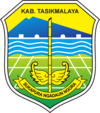Tasikmalaya Regency
|
Tasikmalaya Regency Kabupaten Tasikmalaya |
||
|---|---|---|
| Regency | ||
| Other transcription(s) | ||
| • Sundanese | ᮊᮘᮥᮕᮒᮦᮔ᮪ ᮒᮞᮤᮊ᮪ᮙᮜᮚ | |

Rice field in Tasikmalaya, West Java
|
||
|
||
| Nickname(s): Pearl of the East Preanger München van Java (Munich of Java) |
||
| Motto: Sukapura Ngadaun Ngora | ||
| Location of Tasikmalaya Regency in Indonesia | ||
| Coordinates: 7°10′S 107°56′E / 7.167°S 107.933°E | ||
| Country | Indonesia | |
| Province | West Java | |
| Government | ||
| • Regent | H. Uu Ruzhanul Ulum S.E | |
| Area | ||
| • Total | 2,712.52 km2 (1,047.31 sq mi) | |
| Elevation | 430 m (1,410 ft) | |
| Population (2014) | ||
| • Total | 1,876,544 | |
| Time zone | WIB (UTC+7) | |
| Area code(s) | +62 265 | |
| Website | http://www.tasikmalayakab.go.id | |
Tasikmalaya Regency (pronounced [ˈtasɪʔməˈlaja]) (Indonesian: Kabupaten Tasikmalaya) is a regency in the province of West Java, Indonesia. It covers an area of 2,712.52 km2, and had a population of 1,675,675 at the 2010 Census; the latest official estimate (as at 2014) was 1,876,544. Located in the southeastern region of Priangan (Preanger), the Regency is by far the biggest and the most important regency in East Preanger (Indonesian: Priangan Timur). The Regency was previously administered from Tasikmalaya City, which however is now administratively independent of the Regency (the area and population of the Regency exclude the City), and the administrative centre of the Regency is now at Singaparna to the west of the city.
Most of the Regency features green fields, predominantly occupied by agriculture and forestry, whilst farmers settled as the majority of its population. Tasikmalaya regency is well known for its handicrafts (Indonesian: kerajinan anyaman), salak (zalacca), whilst nasi tutug oncom (hot steamed rice mixed with oncom) known as the Regency's famous dish. The Regency is also known as a major religious centre in West Java, which has more than 800 pesantren (traditional Islamic boarding schools).
Whilst the single word of the name does not convey any apparent meaning in its local languages, many believed that the name Tasikmalaya means either "a large area of sand" or "a large area of mountains".
...
Wikipedia


